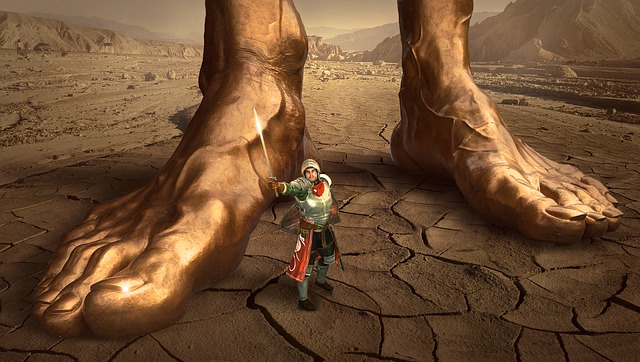Sons of God, Fathers of Giants
By Derek Gilbert
While the early Sumerians were figuring out how to grow crops without rain, interesting things—historic things—were happening far to the northwest.
The second peak in our chronological list of spiritually strategic holy mountains is Mount Hermon. Hermon is the highest, most majestic peak in the Levant. At 9,200 feet above sea level, it dominates the Golan Heights on the border between Israel and Syria, anchoring the southern end of the Anti-Lebanon Mountains. It has been considered sacred for most of human history.
Mount Hermon was a holy site as far back as the old Babylonian period, nearly two millennia before Christ, and probably even earlier. In the Old Babylonian version of the Gilgamesh epic, which dates to the 18th century B.C. (roughly the time of Jacob), “Hermon and Lebanon” were called “the secret dwelling of the Anunnaki.”
The Ninevite version of the poem, written about 600 years later, describes the monster slain by Gilgamesh, Humbaba (or Huwawa), as the guardian of “the abode of the gods.”
The Abode of the Gods

The Anunnaki were the seven chief gods of the Sumerian pantheon: Anu, the sky god; Enlil, god of the air; Enki, god of the earth; Ninhursag, mother goddess of the mountains; Inanna (the Babylonian Ishtar), goddess of sex and war; Sîn, the moon god; and Utu, the sun god.
They are mentioned in texts found in what is today southeastern Iraq that date back to the 27th century B.C. So, the more recent versions of the Gilgamesh story from Babylon and Nineveh may remember more ancient traditions.
The name Hermon appears to be based on a root word that means “taboo,” similar to the Hebrew word kherem, or “devoted to destruction.” The word is often translated into English as “under the ban.”
The first appearance of the word in the Bible is Exodus 22:20: “Whoever sacrifices to any god, other than the Lord alone, shall be devoted to destruction (kherem).” But the ban wasn’t just invoked against disobedient Israelites. Some of the inhabitants of Canaan were also declared kherem by Yahweh—specifically those that were known to be giants, or at least descended from giants.
Who are the Nephilim?

That begs the question: Where did the giants come from? A curious episode is recorded in the first four verses of Genesis chapter 6:1-4:
“When man began to multiply on the face of the land and daughters were born to them, the sons of God saw that the daughters of man were attractive. And they took as their wives any they chose. Then the Lord said, ‘My Spirit shall not abide in man forever, for he is flesh: his days shall be 120 years.’ The Nephilim were on the earth in those days, and also afterward, when the sons of God came in to the daughters of man and they bore children to them. These were the mighty men who were of old, the men of renown.”
Scholars have debated the meaning of the term “Nephilim” for millennia. Most believe it comes from a Hebrew root, napal, meaning “to fall” or “cast down”—literally, “fallen ones.”

However, Bible and ancient language scholar Dr. Michael S. Heiser, author of the excellent book The Unseen Realm (highly recommended) and the new book Reversing Hermon (ditto), contends that this cannot be correct:
“The form nephilim cannot mean ‘fallen ones’ (the spelling would then be nephulim). Likewise, nephilim does not mean ‘those who fall’ or ‘those who fall away’ (that would be nophelim). The only way in Hebrew to get nephilim from naphal by the rules of Hebrew morphology (word formation) would be to presume a noun spellednaphil and then pluralize it. I say ‘presume’ since this noun does not exist in biblical Hebrew — unless one counts Genesis 6:4 and Numbers 13:33, the two occurrences of nephilim — but that would then be assuming what one is trying to prove! However, in Aramaic the noun naphil(a) does exist. It means ‘giant,’ making it easy to see why the Septuagint (the ancient Greek translation of the Hebrew Bible) translated nephilim as gigantes (‘giant’).
In short, the Jewish scholars who translated the Old Testament into Greek about two hundred years before the birth of Jesus clearly understood that the Nephilim were giants, not just men who “fell away” from God.
Likewise, the Hebrew words translated “sons of God” in the passage, bene elohim, refer to divine beings, not mortal men. Now, that hasn’t been the consensus among Christian scholars since about the 5th century, thanks to the great theologian Augustine. He popularized the “sons of Seth” theory to explain away the weird supernatural element of the passages above. In short, the Sethite view is that the sons of God were men from the godly, righteous line of Seth who began intermarrying with women from the corrupt, wicked line of Cain.
Frankly, this defies logic on several points:
- How likely is it that all the Sethite men were good while all the Cainite women were bad?
- We’re supposed to believe Cainite men never married Sethite women?
- Why would these unions produce Nephilim, understood to be giants by Jewish rabbis and early Christians alike?
- Why would these unions lead to wickedness so great that God had to wipe out everything that walked the earth except Noah, his family, and the creatures in the ark?
- Every other use of bene elohim in the Hebrew scriptures refers to divine beings.
Problems with the supernatural understanding of the text usually focus on whether angels and humans could successfully produce children. Proponents of the Sethite view often point to Jesus’ teaching on the resurrection of the dead:
“For in the resurrection [people] neither marry nor are given in marriage but are like angels in heaven” (Matthew 22:30 ESV).
The key words are “in the resurrection” and “in heaven.” Noah’s neighbors were flesh and blood, not resurrected, and the angels who “came in to the daughters of man” were most definitely not in heaven.
Examples of Divine Beings Interacting with Humans

There are several examples in the Bible of divine beings interacting with humans in physical ways—eating, drinking, and even engaging in a dustup in front of the house of Lot (Genesis 19:5-11). Why couldn’t they procreate as well?
The final nails in the coffin of the Sethite view are the references to this event in the New Testament. Both Peter and Jude refer to the only example in scripture where angels transgressed:
“For if God did not spare angels when they sinned, but cast them into hell and committed them to chains of gloomy darkness to be kept until the judgment; if he did not spare the ancient world, but preserved Noah, a herald of righteousness, with seven others, when he brought a flood upon the world of the ungodly; if by turning the cities of Sodom and Gomorrah to ashes he condemned them to extinction, making them an example of what is going to happen to the ungodly…” (2 Peter 2:4, ESV, emphasis added).
“And the angels who did not stay within their own position of authority, but left their proper dwelling, he has kept in eternal chains under gloomy darkness until the judgment of the great day—just as Sodom and Gomorrah and the surrounding cities, which likewise indulged in sexual immorality and pursued unnatural desire, serve as an example by undergoing a punishment of eternal fire” (Jude 6-7, ESV, emphasis added).
If there was any doubt about what the angels did that deserved punishment, Peter and Jude clarified things. They specifically identified the sin of the angels as sexual by linking it to the sins of Sodom and Gomorrah.
Crossing the species barrier between angel and human is just as taboo as the barrier between human and animal.

Derek Gilbert hosts SkyWatchTV, a weekly Christian television program, and co-hosts SciFriday, a weekly television program that looks at science news with his wife, author and analyst Sharon K. Gilbert. His broadcast career spans nearly four decades, with stops in Little Rock, Saint Louis, and Philadelphia, and he’s been interviewing guests for his podcast, A View from the Bunker, since 2009. Derek is author of the groundbreaking books The Great Inception and Last Clash of the Titans. He’s also the co-author with Josh Peck of The Day the Earth Stands Still, which exposes the occult origins of the modern UFO phenomenon. His forthcoming book, Bad Moon Rising: Islam, Armageddon, and the Most Diabolical Double-Cross in History will be published in the summer of 2019. Derek and Sharon are currently writing Profiling the Dead, about ancient death cults and the Bible, which should be out in late 2019. Derek is a popular conference speaker, a lifelong fan of the Chicago Cubs, prefers glasses to contacts, and has been known to sing the high part in barbershop and gospel quartets. Find out more at www.derekpgilbert.com, www.gilberthouse.org, www.vftb.net, and www.SkyWatchTV.com.






It is such a blessing to have wonderful men and women of Father bringing the real truth to light…my prayer is that more people will be given eyes to see and ears to hear as time draws near. God bless you!!